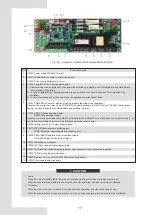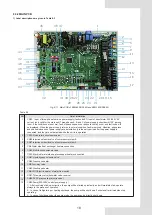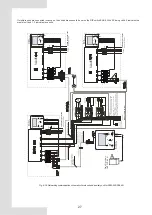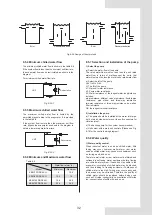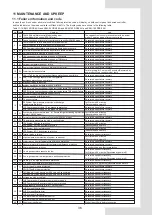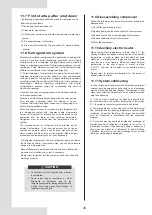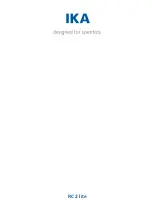
8.5 Water system installation
Connection requirements of chilled water pipes
a) All chilled water pipelines should be thoroughly
flushed, to be free of any impurity, before the unit is
operated. Anyimpurity should not be flushed to or into
the heat exchanger.
b) Water must enter the heat exchanger through the
inlet; otherwise the performance of the unit will decline.
c) The inlet pipe of the evaporator must be provided with
a target flow controller, to realize flow-break protection
for the unit. Both ends of the target flow controller must
be supplied with horizontal straight pipe sections whose
diameter is 5 times that of the inlet pipe. The target flow
controller must be installed in strict accordance with
“Installation & Regulation Guide for Target Flow
Controller” (Fig.8-28,8-29). The wires of the target flow
controller should be led to the electric cabinet through
shielded cable (see Electric Controlling Schematic
Diagram for details). The working pressure of the target
flow controller is 1.0MPa, and its interface is 1 inch in
diameter. After the pipelines are installed, the target flow
controller will be set properly according to the rated
water flow of the unit.
d) The pump installed in the water pipeline system
should be equipped with starter. The pump will directly
press water into the heat exchanger of the water system.
e) The pipes and their ports must be independently
supported but should not be supported on the unit.
f) The pipes and their ports of the heat exchanger should
be easy to disassemble for operation and cleaning, as
well as inspection of port pipes of the evaporator.
g) The evaporator should be provided with a filter with
more than 40 meshes per inch at site. The filter should
be installed near to the inlet port as much as possible,
and beunder heat preservation.
h) The by-pass pipes and by-pass valves as shown in
Fig.8-23 must be mounted for the heat exchanger, to
facilitate cleaning of the outside system of water
passage before the unit is adjusted. During
maintenance, the water passage of the heat exchanger
can be cut off without disturbing other heat exchangers.
i) The flexible ports should be adopted between the
interface of the heat exchanger and on-site pipeline, to
reduce transfer of vibration to the building.
j) To facilitate maintenance, the inlet and outlet pipes
should be provided with thermometer or manometer.
The unit is not equipped with pressure and temperature
instruments, so they need to be purchased by the user.
k) All low positions of the water system should be
providedwith drainage ports, to drain water in the
evaporator and the system completely; and all high
positions should be supplied with discharge valves, to
facilitate expelling air from the pipeline. The discharge
valves and drainage ports should not be under heat
preservation, to facilitate maintenance.
l) All possible water pipes in the system to be chilled
should be under heat preservation, including inlet pipes
and flanges of the heat exchanger.
m) The outdoor chilled water pipelines should be
wrapped with an auxiliary heating belt for heat
preservation, and the material of the auxiliary heat belt
should be PE, EDPM, etc., with thickness of 20mm, to
prevent the pipelines from freezing and thus cracking
under low temperature. The power supply of the heating
belt should be equipped with an independent fuse.
n) The temperature sensor of the total outlet water of No.
0 master unit needs to be installed in the main outlet
water pipe of the project.
After the unit is in place, chilled water pipes
can be laid.
The relevant installation regulations should
be abided with when conducting connection
of water pipes.
The pipelines should be free of any impurity,
and all chilled water pipes must conform to
local rules and regulations of pipeline
engineering.
CAUTION
8.5.1 Basic requirements of connection
of chilled water pipes
NOTE
When the power cord is parallel to the signal wire,
make sure that they are enclosed in respective
conduits and are kept a reasonable wire spacing.
(Distance between the power cord and signal wire:
300mm if below 10A, and 500mm if below 50A)
WARNING
For the water pipeline network including
filters and heat exchangers, dreg or dirt may
seriously damages the heat exchangers and
water pipes.
The installation persons or the users must
ensure the quality of chilled water, and
de-icing salt mixtures and air should be
excluded from the water system, since they
may oxidize and corrode steel parts inside
the heat exchanger.
When the ambient temperature is lower than
2
℃
, and the unit will be not used for a long
time, water inside the unit should be drained.
If the unit is not drained in winter, its power
supply should not be cut off, and the fan coils
in the water system must be provided with
three-way valves, to ensure smooth
circulation of the water system when the
anti-freezing pump is started up in winter.
For
KEM-180 DRS5 KH
, the temperature
sensor of the total outlet water of
the master unit module A (the uint
address of DIP switches is 0) must be
repositioned on the water outlet main of
the project.
30


